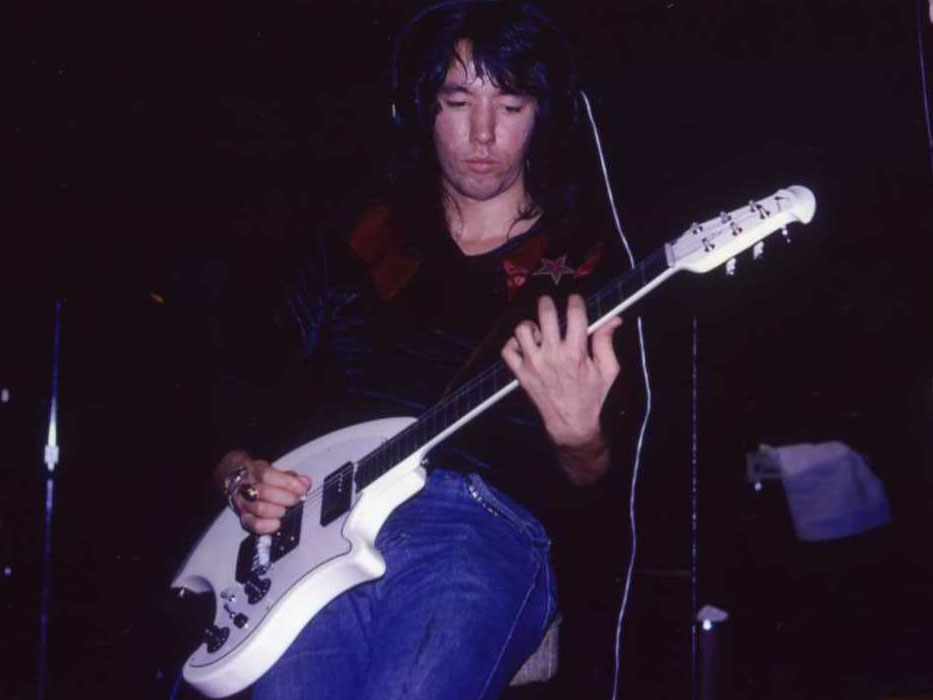
Hotel Diplomat July 13, 1973
Photo by Lydia Criss

For reasons unknown Ace moved on from the Epiphone Coronet and some time during the summer of 1973 he ended up with an Ovation Breadwinner. The Breadwinner was introduced in 1971, with sales staring in 1972, and it was Ovation's first foray into the world of electric solidbody guitars. Although often lauded for its ergonomical design, according to the designer it was apparently designed to resemble a "medieval battle axe because musicians at the time often referred to their instruments as their 'axe'". The Breadwinner had a mahogany body with a maple neck and an ebony fingerboard. As seen below, Ace first shows up with his 1251-6 Breadwinner, the '6' being the suffix for the white version, on July 13. This guitar was either a '72 or '73. It's well known that in 1973 the band had virtually no money and a 1973 Breadwinner had a retail price of $349 so it seems unlikely that Ace bought it new. A used 1972 is more plausible.


The original Breadwinner pickups were "Toroidal" which, according to the 1973 Ovation catalog, had 12 individual magnetic poles—six rectangular and six circular—the latter of which were adjustable. Ace summarily replaced them with DiMarzios. "I used a crazy-looking Ovation that had an old hand-wound DiMarzio pick-up in it for a few early gigs." (Metal Edge presents: KISS Alive!, 1996) There are, to my knowledge, no pictures that show Ace playing or posing with the Breadwinner with its original pickups. One thing that is odd is that neither the July 13 or August 10 photos above seem to show any switches but I assume that it has to do with the quality of the photos rather than having been actual modifications.
The Breadwinner had what is generally regarded as the first active electronic system in the shape of a FET preamp which was powered by two 9-volt batteries hidden behind a metal plate on the back of the guitar. Its controls were somewhat irregular compared to a regular guitar. The volume, the knob located closest to the bridge, was the one thing that was normal. The tone knob had the "full-on" setting of other guitars at the midpoint which means it could get really bright, and in conjunction with the "band rejection filter" of one of the mini switches (essentially a midrange bypass) it was capable of a wide variety of tones. The three-way pickup selector (the second, lower mini switch) was also slightly odd in that that it had the following positions: neck, bridge, and both pickups out of phase. Compared to most two-pickup guitars which have neck, both (in phase), and bridge this would have been awkward for most players. For a player like Ace, who more or less never uses his neck pickup, it might not have mattered much.

Both the Le Tang pic above and the photos from the recording of the first album below show the guitar with modified controls. It appears that the original three-way selector has been moved and replaced with something else (possibly just a small coverup of some kind). The Breadwinner had its controls mounted on a circuit board so for Ace to add the new switch it's very likely that he had the better part of the original circuitry removed and converted to a more regular volume/tone/PU-switch setup. Interesting to note about the pictures from the first album recording sessions is that the pickups have gotten regular chrome covers. Whether or not the pickups themselves have been changed is unknown but it's not altogether unlikely that Ace wired in some standard Gibson PAFs for the recording. This Ovation Breadwinner was Ace's main guitar for the recording of the classic eponymous first album. The only other guitar he has been pictured with during those sessions is a Fender Thinline Telecaster.


Some time in December of 1973 Ace used the advance money from Casablanca and bought his cherished Les Paul Deluxe. It first appears for the club gig at the Coventry on December 21 and was the undisputed no. 1 for Ace from then on. But the Breadwinner hung around for a bit as a backup. It can be seen standing on Ace's side of the stage at the Coventry and during the rehearsals at Filmore East it was brought out again. It might have been used as a backup for a little while in early 1974 but after the rehearsal shot below it doesn't appear in any pictures again.

